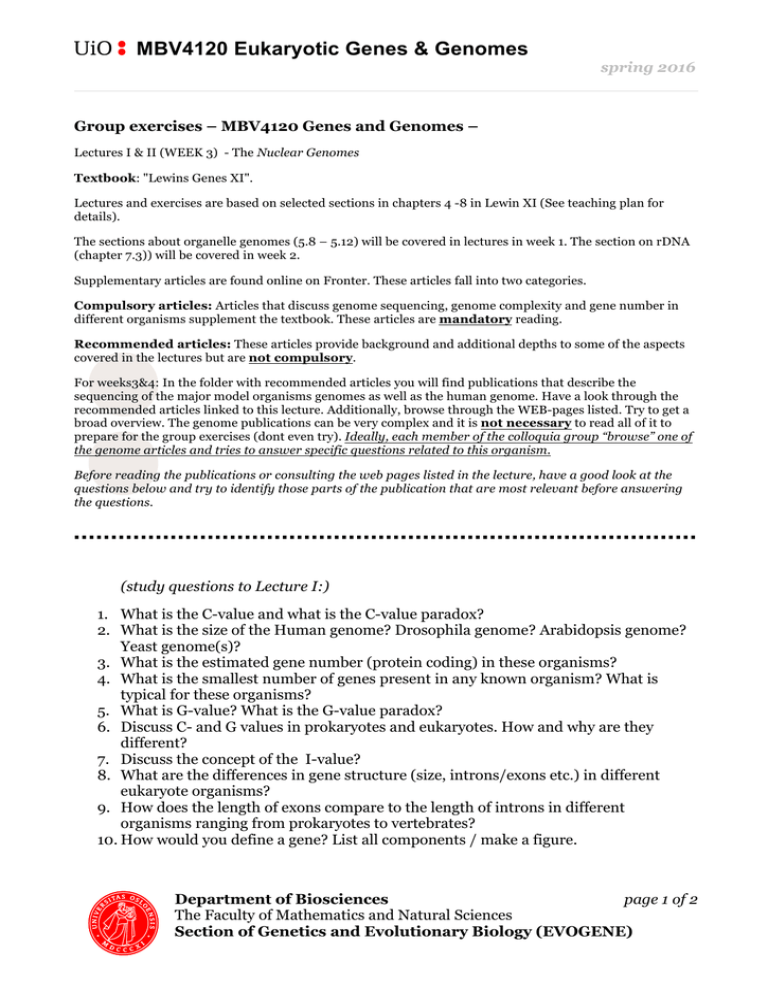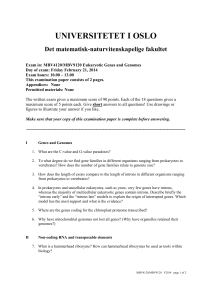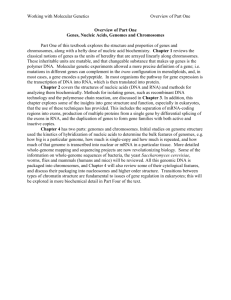MBV4120 Eukaryotic Genes & Genomes spring 2016
advertisement

MBV4120 Eukaryotic Genes & Genomes spring 2016 Group exercises – MBV4120 Genes and Genomes – Lectures I & II (WEEK 3) - The Nuclear Genomes Textbook: "Lewins Genes XI". Lectures and exercises are based on selected sections in chapters 4 -8 in Lewin XI (See teaching plan for details). The sections about organelle genomes (5.8 – 5.12) will be covered in lectures in week 1. The section on rDNA (chapter 7.3)) will be covered in week 2. Supplementary articles are found online on Fronter. These articles fall into two categories. Compulsory articles: Articles that discuss genome sequencing, genome complexity and gene number in different organisms supplement the textbook. These articles are mandatory reading. Recommended articles: These articles provide background and additional depths to some of the aspects covered in the lectures but are not compulsory. For weeks3&4: In the folder with recommended articles you will find publications that describe the sequencing of the major model organisms genomes as well as the human genome. Have a look through the recommended articles linked to this lecture. Additionally, browse through the WEB-pages listed. Try to get a broad overview. The genome publications can be very complex and it is not necessary to read all of it to prepare for the group exercises (dont even try). Ideally, each member of the colloquia group “browse” one of the genome articles and tries to answer specific questions related to this organism. Before reading the publications or consulting the web pages listed in the lecture, have a good look at the questions below and try to identify those parts of the publication that are most relevant before answering the questions. (study questions to Lecture I:) 1. What is the C-value and what is the C-value paradox? 2. What is the size of the Human genome? Drosophila genome? Arabidopsis genome? Yeast genome(s)? 3. What is the estimated gene number (protein coding) in these organisms? 4. What is the smallest number of genes present in any known organism? What is typical for these organisms? 5. What is G-value? What is the G-value paradox? 6. Discuss C- and G values in prokaryotes and eukaryotes. How and why are they different? 7. Discuss the concept of the I-value? 8. What are the differences in gene structure (size, introns/exons etc.) in different eukaryote organisms? 9. How does the length of exons compare to the length of introns in different organisms ranging from prokaryotes to vertebrates? 10. How would you define a gene? List all components / make a figure. Department of Biosciences page 1 of 2 The Faculty of Mathematics and Natural Sciences Section of Genetics and Evolutionary Biology (EVOGENE) 2 11. How can genes be identified using bioinformatics? 12. What is the difference between the genome and the transcriptome of an organism, and which would you expect to be cell type-specific? 13. What is synteny? How can syntenic genomic regions be used in research? (study questions to lecture II:) 14. Make a list of the different factors that would explain why the genomes of higher organisms are larger than what is expected from a simple increase in the number of genes? 15. How many different types of genes do we have and why is this number different from the total number of genes? 16. How large is the fraction of the human genome that encode the exons (producing proteins? 17. What are homologues, orthologues and paralogs? 18. To what degree can homologues of human genes be found in different organisms ranging from prokaryotes to vertebrates? What may this tell us about the function of these genes? 19. What is a gene family, and how does it originate? 20. To what degree do we find gene families in different organisms ranging from prokaryotes to vertebrates? How does the number of gene families relate to genome size? 21. Will genes that code for the same protein in different organisms be most similar to each other at the DNA or amino acid level? 22. In multicellular eukaryotes, what accounts for the variety in gene sizes? 23. Are introns borders between functional domains? 24. Genomes contain both repeated and non-repeated DNA sequences. What do the non-repeated DNA sequences contain? 25. List and describe the different types of repeated DNA sequences? 26. The relative amounts of repeated and non-repeated DNA sequences differ in different genomes. What are the ratios of repeated and non-repeated DNA sequences in the genomes of different model organisms and humans? 27. What is satellite DNA? Where is satellite DNA located in chromosomes? 28. What is the (mechanistic) origin of the length variation observed in mini- and micro-satellite DNA? 29. In prokaryotes and unicellular eukaryotes, such as yeast, very few genes have introns, whereas the majority of multicellular eukaryotic genes contain introns. Discuss the evidence that supports both the “introns early” and the “introns late” models to explain the origin of interrupted genes. Which has the most support? 30. How do gene duplications promote diversity in evolution? 31. What is the “2R hypothesis”? What evidence is there for it? Department of Biosciences page 2 of 2 The Faculty of Mathematics and Natural Sciences Section of Genetics and Evolutionary Biology (EVOGENE)








